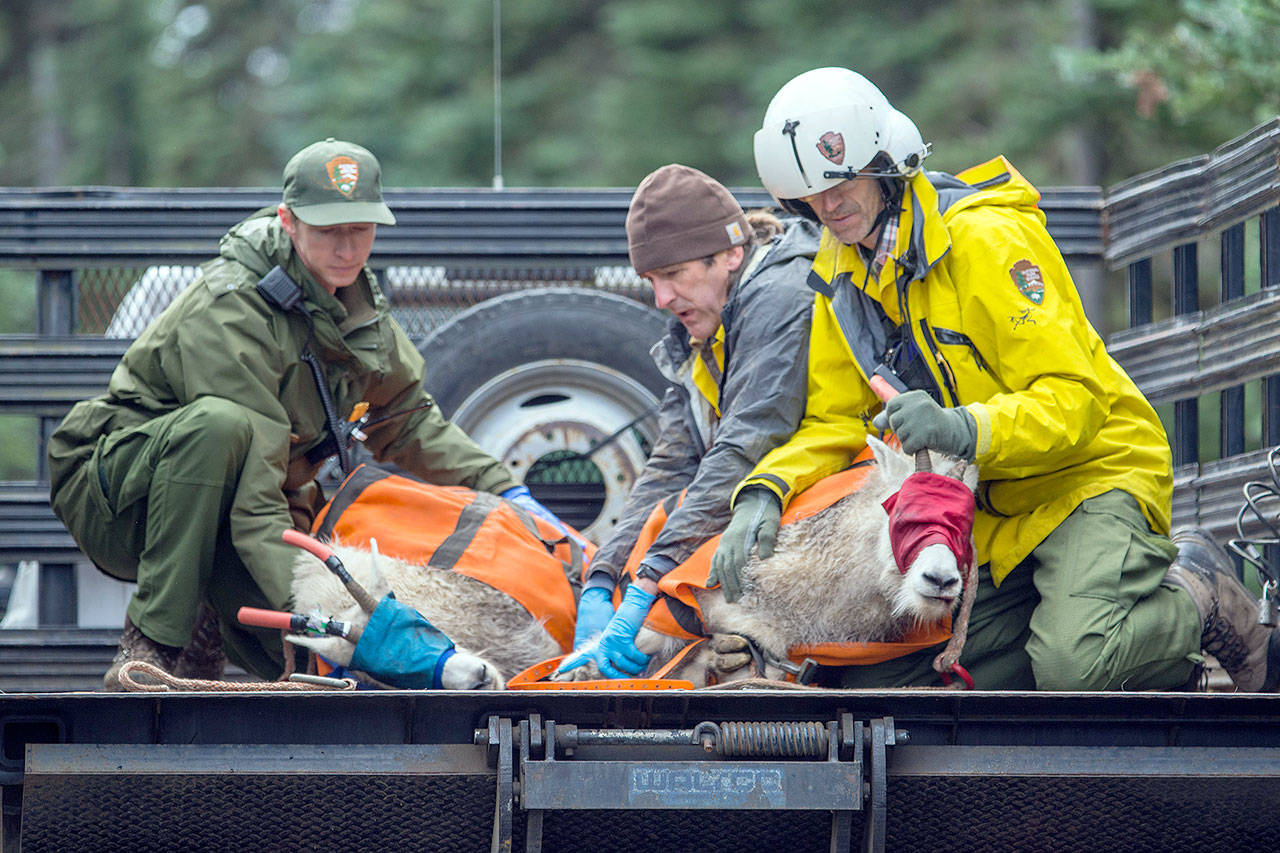OLYMPIC NATIONAL PARK — Olympic National Park’s mountain goats have begun a historic journey back to their native habitat in the North Cascades.
Operations to move as many of the estimated 700 mountain goats as possible began last week — an effort that includes helicopters, tranquilizer darts, nets and refrigerated trucks.
“That’s the hardest part of this whole operation — making sure the stress the animal is under during transportation is minimized,” said Jenny Powers, National Park Service wildlife veterinarian.
Monday marked the beginning of a five-year operation. Leading Edge Aviation, park staff, veterinarians and officials from other agencies are working together to capture as many goats as possible.
It’s a joint effort by the National Park Service, the state Department of Fish and Wildlife, the U.S. Forest Service, and area tribes.
The current effort will continue through the end of next week. Crews will conduct operations in two two-week spurts during each of the remaining years.
Here’s how they do it.
The helicopter crew flies as close as possible to the goats for a successful capture. They can get within 30 feet.
The gunner on the helicopter makes a decision to either shoot a tranquilizer dart or a net at the goat, a decision that is partly based on how steep the terrain is.
Then a crew member exits the helicopter and blindfolds the goat — an effort that helps reduce stress — before putting it on a sling to be flown several minutes away to a landing spot on Hurricane Ridge.
There, the goats are loaded into the back of a truck to be transported to processing, where veterinarians examine them before they are transported to the North Cascades.
As of last week, crews have captured 36 mountain goats, seven of which were caught Thursday, Sept. 13.
For Patti Happe, Olympic National Park wildlife branch chief, it’s exciting to see the goats on their way back to their native habitat.
“It was a long process and it feels really great to have it happen,” she said. “I didn’t really believe it was going to happen until the helicopter landed on Monday morning.”
So far operations have focused on the goats that live on Klahhane Ridge. From there it’s about a 10- to 15-minute flight back to the landing area.
The flight from Mount Olympus, where most of the goats live, takes about half an hour.
Officials said they would have preferred to begin the operation earlier in the summer, but the public process pushed the translocation effort into September.
“I’m really surprised we’ve been able to fly every day and have been able to catch goats every day,” Happe said. “We’re about done with Klahhane, but the weather has to lift if we’re getting to (Mount) Olympus, which is where most of them are.”
Each of the goats captured must undergo a veterinary examination before making the journey via refrigerated truck to the North Cascades. The chilled trucks are said to help keep the goats calm as they travel.
Dr. Allison Case, Northwest Trek Wildlife Park veterinarian, is one of several veterinarians checking the goats’ health before they are ready to go.
Most have been in perfect health, she said.
Veterinarians collect blood, DNA samples and nasal swabs, listen to lungs and hearts and do other physical examinations.
So far there have been few injuries. One goat had a horn broken during capture, but officials said they anticipate a full recovery.
Each goat gets an ID tag in its ear and adults get radio collars.
“That’s all critical information for the biologist to follow their progress after release,” Case said. “The radio collars eventually fall away, but the ear tag identifiers are for the rest of their lives.”
As veterinarians examine the goats, they use gloves. Case said that is largely because it is standard practice, but also because they protect them from the sedatives that are used on the goats.
The darts used in the field contain carfentanil. Vets also use haloperidol and midazolam to calm the goats.
Powers said that this is part of a new drug protocol and part of it requires officials to learn as they go.
“We’ve taken the history of what others have used, and we’re trying to use some of the new capture-type drugs to reduce the stress on the animal,” she said.
Goat nannies and their kids are transported together to reduce stress. They are shipped in modified crates that allow them to face each other during the transport. A mesh between them allows them to see and smell each other.
“We just want to do what we can to keep the mom and kid together and to keep them comfortable,” Case said.
Nannies and their kids then are released together in the North Cascades.



